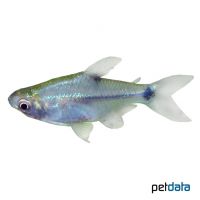Three-Spot Tetra (Serrapinnus kriegi)
| Three-Spot Tetra Serrapinnus kriegi | |
|---|---|
| Name | Three-Spot Tetra |
| Name Lat. | Serrapinnus kriegi |
| Synonym | Cheirodon kriegi |
| Family | Characins |
| Family lat. | Characidae |
| Order | Characins |
| Order lat. | Characiformes |
| Origin | South America |
| Habitat | Streams, ponds |
| Diet | Omnivore |
| pH | 5.5-7.5 |
| Behavior | Peaceful |
| Keeping | Group |
| Care Level | Moderate |
| Reproduction | Egg scatterer |
| Breeding | Moderately difficult |
| Life Span | 3-5 years |
| Protection | No |
| Metric Units | |
| Size | 4-5 cm |
| Temperature | 24-29 °C |
| Hardness | 5-15 °dH |
| Aquarium | 80 l |
| US Units | |
| Size | 1.6"-2" |
| Temperature | 75-84 °F |
| Hardness | 89-267 ppm |
| Aquarium | 20 gal |
Distribution and habitat
Three-spotted tetra are native to the Paraguay River basin (Paraguay, Brazil), where they are found primarily in slow-moving waters with dense, often overhanging riparian vegetation and muddy soft bottoms.
Maintenance
The aquarium should have a varied, partly dense planting, with shelters and hiding places (roots) and provide sufficient swimming space. Soft, slightly acidic water, a dark substrate covered with some foliage (e.g. sea almond leaves), shaded light (floating plants) and a weak current is ideal.
No ammonia, ammonium and nitrite must be detectable in the water, the nitrate value must not exceed 100 mg/l. To ensure the water quality and oxygen content, a filter and heater adapted to the aquarium size is required, as well as lighting for the species-appropriate day-night rhythm of the animals.
Diet
In nature they feed mainly on small insects and larvae. The food supply consists of live, frozen and dry food. For a balanced diet, feed them once a day with a high-quality dry food (flakes, granules, pellets) as well as cyclops, daphnia or mosquito larvae (live or frozen). In addition, they regularly need some plant food, such as algae leaves or dry food with plant ingredients (e.g. spirulina)
It is recommended to feed small portions several times a day, which are eaten within a few minutes. A regular and varied diet promotes health and prevents deficiency symptoms.
Behaviour and compatibility
They are swimming, peaceful schooling fish and well suited for a community tank with other, not too large and peaceful fish. At least 5, but better much more animals should be kept together.
In principle, only mutually compatible fish species with similar requirements to the water condition and water temperature may be socialized.
Sex dimorphism
The sexes are difficult to distinguish. The females are somewhat stronger and larger
Reproduction and breeding
In soft, slightly acidic peat water they usually spawn between fine-feathered plants (free spawners). The larvae hatch after 24-36 hours and swim freely after 4-5 days.
Juveniles must be fed several times a day with special rearing food (dust food). Breeding is hardly possible in a community tank, as the spawn is easy prey here.
Important
The foliage (sea almond tree, oak, etc.) enriches the water with humic substances, naturally lowers the pH and, when rotting, promotes the development of microorganisms, which are a valuable secondary food source.
The well-being of the fish should be monitored regularly. Temperature should be checked daily, pH, hardness and nitrate levels should be checked at least every 14 days. Regular partial water changes are recommended, even when contaminant levels have not yet reached the upper limit. Sudden changes in water quality should be avoided. Newly introduced fish must be accustomed slowly to the water in the aquarium.
Further literature can be found in your pet store
References
Text: petdata; Image: petdata
Source: BMELV (1998): Tierschutzgutachten - Haltung von Zierfischen (Süßwasser); ENGELMANN (2005): Zootierhaltung - Tiere in menschlicher Obhut: Fische, Verlag Harri Deutsch
- Gemäß § 21 Abs. 5 Tierschutzgesetz idgF
